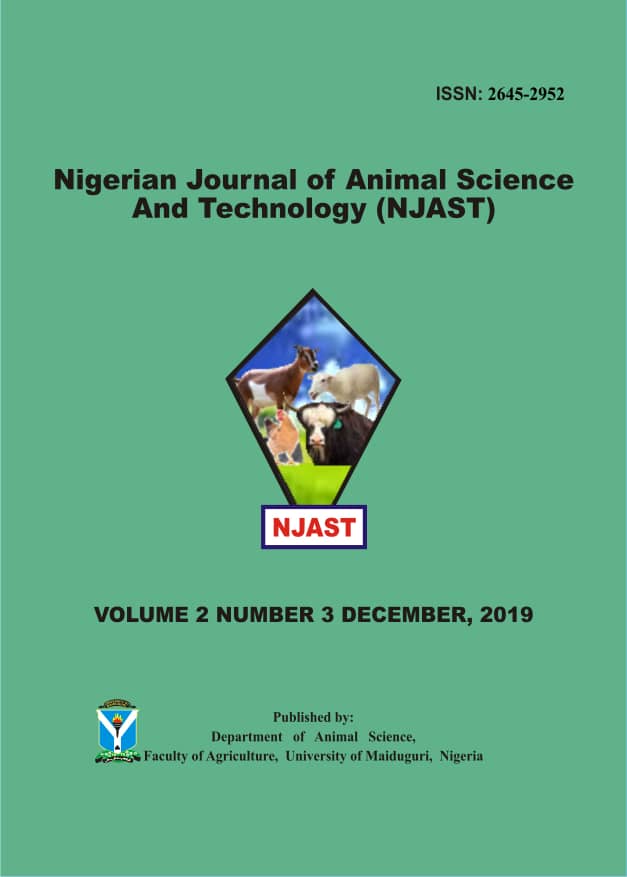Chemical Composition and Comprehensive Strength of Urea Molasses Blocks Supplements Produced Using Different Drying Methods and Binding Agents
Abstract
The study was designed to evaluate the chemical composition and comprehensive strength of
urea molasses blocks produced using different binding agents, fibre sources and drying
methods. Different blocks were produced and dried for seven (7) days under the shade and sun.
Dry matter content was higher (92.7%) in sun dried rice bran with cement (SRWC) and lowest
(88.0%) in shade dried wheat offal with cement (SHWWC). Organic matter was higher (90.1%)
in SRWC and lowest 82.7% in shade dried wheat offal with termite mud (SHWWM). Sun drying
method reduced crude protein up to 46.92%. Ash content was highest (5.98%) in SHWWM and
lowest (2.68%) in SRWC. Neutral detergent and acid detergent fibre (NDF and ADF) were
higher 25.6% and 16.6% in SRWC and least 20.2% and 12.1% in SHWWM respectively. In
comprehensive strength, sun dried rice bran with termite mud (SRWM) and SRWC had the
highest strength compared to SHWWM and SHWWC. Sun drying method reduced crude protein
content and significantly increased comprehensive strength. Blocks with rice bran contained
higher NDF and ADF values. Using any of the binding agents, Shade drying is recommended
as the best drying method.
Downloads
References
Aye P. A., and Adegun M. K. (2010). Digestibility and growth in West African dwarf sheep fed gliricidia – based multi-nutrient block supplements. Agricultural and Biology Journal of North America 1(6): 1133–1139.
Bauchi State Government Diary (BASGD), 2006 Published by BREPOL
Garg M. R. and Gupta B. N. (1992). Effect of supplementing urea molasses mineral block lick to straw based diet on DM intake and nutrient utilization. Asian-Australian Journal of Animal Science 5(5):39-44.
Garg M. R., Mehta A. K., and Singh D. K. (1998). Advances in the production and use of urea molasses mineral blocks in India. World Animal Review 90:22-27.
Geleta T., Negesse T., Abebe G. and Geotsch A. L. (2013). Effect of supplementing grazing Arsi-Bale sheep with molasses-urea feed block on weight gain and economic return under farmers’ management condition. Journal of Cell Animal Biology 7(10): 125-131
Hassoun P. (1989). Manufacture of Urea Blocks without Molasses. A Monograph, FAO, Rome, Italy.
Hosamani S. V., Mehra U. R., Dass R. S. (1995). Effect of dietary urea levels on intake of urea molasses mineral block (UMMB) and utilization of nutrients in adult buffaloes. Indian Journal of Animal Nutrition 12:67-72.
Hosamani S. V., Mehra U. R., Dass R. S. (1998). Effect of different planes of nutrition on urea molasses mineral block intake, nutrient utilization, rumen fermentation pattern and blood profile in Murrah buffaloes (Bubalus bubalis). Animal Feed Science Technology 76:117-128.
Mehra U. R., Challa J. and Singh U. B. (1993) Nutrient utilization and rumen fermentation pattern in buffaloes fed rations supplemented with formaldehyde treated urea molasses mineral block. Journal of Applied Animal Resources 4:67-72
Mohammed I. D., Baulube M. and Adeyinka I. A. (2007). Multinutrient Blocks 1: Formulation and Production under a Semi-Arid Environment of North East Nigeria. Nigeria Journal of Biological Science 7 (2):389-392
Mubi A.A., Mohammed I. D. and Kibon A (2013). Effects of multinutrient blocks supplementation on the performance of Yankasa sheep fed with basal diet of rice straw in the dry season of Guinea Savanna Region of Nigeria. Archives of Applied Science Research 5 (4):172-178
Onwuka C. F. I. (1999). Molasses block supplementary feed resources for ruminants. Archvos De Zootecnia 48 (181):89-94
Ramchurn R. and Raggoo A. (2000). The development of multi-nutrient blocks for the domestic rabbit in Mauritus. Livestock Research for Rural Development 12 (1).
Thu N V, Uden P. (2001). Effect of work and urea molasses cake supplementation of swamp buffaloes fed rice straw or grasses on rumen environment, feed degradation and intake. Asian- Australasian Journal of Animal Sciences 14(5):631-639.
Thu N. V. and Uden P. (2000). Effect of urea molasses cake supplementation on live weight and milk yield of Murrah buffalo cows. Asian-Australasian Journal of Animal Sciences 13(9):1329-36.
Topps S., Verma A. K., Dass R. S. and Mehra U. R. (1997). Nutrient utilization and rumen fermentation pattern in crossbred cattle fed on different planes of nutrition supplemented with urea molasses mineral block. Animal Feed Science Technology 64: 101-112.
Van Soest P. J. and Robertson, J. B. (1985). Analysis of Forages and Fibrous Foods. A Laboratory Manual for Animal Science. Cornell University, Ithaca, NY.
Yerima J. (2008). Evaluation of Multinutrient Blocks Supplementation on Growth Performance and Haematological Parameters of Yankasa Rams. An MSc Thesis presented to the school of postgraduate studies, Abubakar Tafawa Balewa University, Bauchi



